Shion Guha
Human-Aligned Faithfulness in Toxicity Explanations of LLMs
Jun 23, 2025Abstract:The discourse around toxicity and LLMs in NLP largely revolves around detection tasks. This work shifts the focus to evaluating LLMs' reasoning about toxicity -- from their explanations that justify a stance -- to enhance their trustworthiness in downstream tasks. Despite extensive research on explainability, it is not straightforward to adopt existing methods to evaluate free-form toxicity explanation due to their over-reliance on input text perturbations, among other challenges. To account for these, we propose a novel, theoretically-grounded multi-dimensional criterion, Human-Aligned Faithfulness (HAF), that measures the extent to which LLMs' free-form toxicity explanations align with those of a rational human under ideal conditions. We develop six metrics, based on uncertainty quantification, to comprehensively evaluate \haf of LLMs' toxicity explanations with no human involvement, and highlight how "non-ideal" the explanations are. We conduct several experiments on three Llama models (of size up to 70B) and an 8B Ministral model on five diverse toxicity datasets. Our results show that while LLMs generate plausible explanations to simple prompts, their reasoning about toxicity breaks down when prompted about the nuanced relations between the complete set of reasons, the individual reasons, and their toxicity stances, resulting in inconsistent and nonsensical responses. We open-source our code and LLM-generated explanations at https://github.com/uofthcdslab/HAF.
How do datasets, developers, and models affect biases in a low-resourced language?
Jun 07, 2025Abstract:Sociotechnical systems, such as language technologies, frequently exhibit identity-based biases. These biases exacerbate the experiences of historically marginalized communities and remain understudied in low-resource contexts. While models and datasets specific to a language or with multilingual support are commonly recommended to address these biases, this paper empirically tests the effectiveness of such approaches in the context of gender, religion, and nationality-based identities in Bengali, a widely spoken but low-resourced language. We conducted an algorithmic audit of sentiment analysis models built on mBERT and BanglaBERT, which were fine-tuned using all Bengali sentiment analysis (BSA) datasets from Google Dataset Search. Our analyses showed that BSA models exhibit biases across different identity categories despite having similar semantic content and structure. We also examined the inconsistencies and uncertainties arising from combining pre-trained models and datasets created by individuals from diverse demographic backgrounds. We connected these findings to the broader discussions on epistemic injustice, AI alignment, and methodological decisions in algorithmic audits.
BTPD: A Multilingual Hand-curated Dataset of Bengali Transnational Political Discourse Across Online Communities
Jun 07, 2025Abstract:Understanding political discourse in online spaces is crucial for analyzing public opinion and ideological polarization. While social computing and computational linguistics have explored such discussions in English, such research efforts are significantly limited in major yet under-resourced languages like Bengali due to the unavailability of datasets. In this paper, we present a multilingual dataset of Bengali transnational political discourse (BTPD) collected from three online platforms, each representing distinct community structures and interaction dynamics. Besides describing how we hand-curated the dataset through community-informed keyword-based retrieval, this paper also provides a general overview of its topics and multilingual content.
Talking About the Assumption in the Room
Feb 18, 2025Abstract:The reference to assumptions in how practitioners use or interact with machine learning (ML) systems is ubiquitous in HCI and responsible ML discourse. However, what remains unclear from prior works is the conceptualization of assumptions and how practitioners identify and handle assumptions throughout their workflows. This leads to confusion about what assumptions are and what needs to be done with them. We use the concept of an argument from Informal Logic, a branch of Philosophy, to offer a new perspective to understand and explicate the confusions surrounding assumptions. Through semi-structured interviews with 22 ML practitioners, we find what contributes most to these confusions is how independently assumptions are constructed, how reactively and reflectively they are handled, and how nebulously they are recorded. Our study brings the peripheral discussion of assumptions in ML to the center and presents recommendations for practitioners to better think about and work with assumptions.
"This is not a data problem": Algorithms and Power in Public Higher Education in Canada
Mar 22, 2024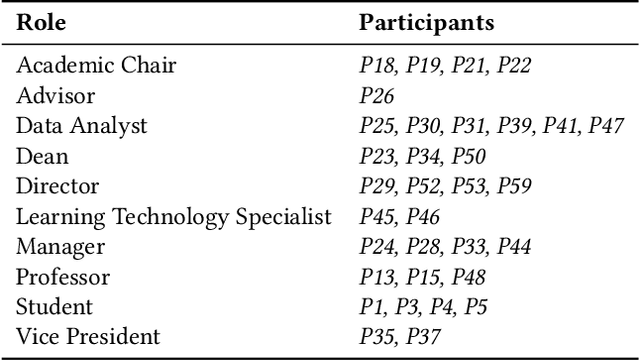
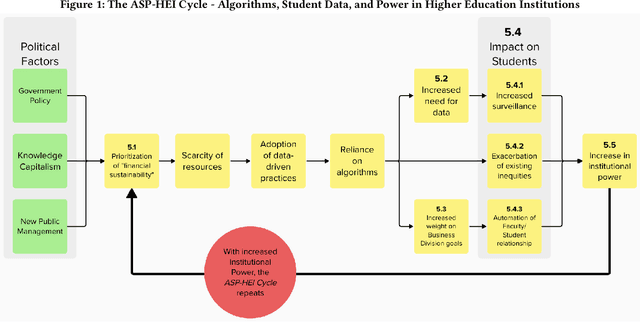
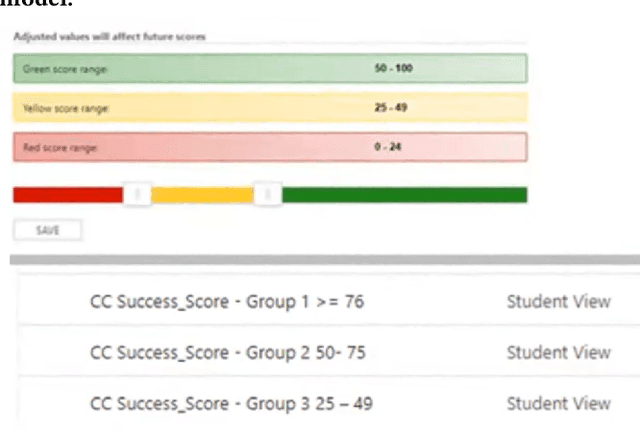
Abstract:Algorithmic decision-making is increasingly being adopted across public higher education. The expansion of data-driven practices by post-secondary institutions has occurred in parallel with the adoption of New Public Management approaches by neoliberal administrations. In this study, we conduct a qualitative analysis of an in-depth ethnographic case study of data and algorithms in use at a public college in Ontario, Canada. We identify the data, algorithms, and outcomes in use at the college. We assess how the college's processes and relationships support those outcomes and the different stakeholders' perceptions of the college's data-driven systems. In addition, we find that the growing reliance on algorithmic decisions leads to increased student surveillance, exacerbation of existing inequities, and the automation of the faculty-student relationship. Finally, we identify a cycle of increased institutional power perpetuated by algorithmic decision-making, and driven by a push towards financial sustainability.
Beyond Predictive Algorithms in Child Welfare
Feb 26, 2024


Abstract:Caseworkers in the child welfare (CW) sector use predictive decision-making algorithms built on risk assessment (RA) data to guide and support CW decisions. Researchers have highlighted that RAs can contain biased signals which flatten CW case complexities and that the algorithms may benefit from incorporating contextually rich case narratives, i.e. - casenotes written by caseworkers. To investigate this hypothesized improvement, we quantitatively deconstructed two commonly used RAs from a United States CW agency. We trained classifier models to compare the predictive validity of RAs with and without casenote narratives and applied computational text analysis on casenotes to highlight topics uncovered in the casenotes. Our study finds that common risk metrics used to assess families and build CWS predictive risk models (PRMs) are unable to predict discharge outcomes for children who are not reunified with their birth parent(s). We also find that although casenotes cannot predict discharge outcomes, they contain contextual case signals. Given the lack of predictive validity of RA scores and casenotes, we propose moving beyond quantitative risk assessments for public sector algorithms and towards using contextual sources of information such as narratives to study public sociotechnical systems.
The "Colonial Impulse" of Natural Language Processing: An Audit of Bengali Sentiment Analysis Tools and Their Identity-based Biases
Jan 19, 2024



Abstract:While colonization has sociohistorically impacted people's identities across various dimensions, those colonial values and biases continue to be perpetuated by sociotechnical systems. One category of sociotechnical systems--sentiment analysis tools--can also perpetuate colonial values and bias, yet less attention has been paid to how such tools may be complicit in perpetuating coloniality, although they are often used to guide various practices (e.g., content moderation). In this paper, we explore potential bias in sentiment analysis tools in the context of Bengali communities that have experienced and continue to experience the impacts of colonialism. Drawing on identity categories most impacted by colonialism amongst local Bengali communities, we focused our analytic attention on gender, religion, and nationality. We conducted an algorithmic audit of all sentiment analysis tools for Bengali, available on the Python package index (PyPI) and GitHub. Despite similar semantic content and structure, our analyses showed that in addition to inconsistencies in output from different tools, Bengali sentiment analysis tools exhibit bias between different identity categories and respond differently to different ways of identity expression. Connecting our findings with colonially shaped sociocultural structures of Bengali communities, we discuss the implications of downstream bias of sentiment analysis tools.
A Human-Centered Review of Algorithms in Decision-Making in Higher Education
Feb 12, 2023Abstract:The use of algorithms for decision-making in higher education is steadily growing, promising cost-savings to institutions and personalized service for students but also raising ethical challenges around surveillance, fairness, and interpretation of data. To address the lack of systematic understanding of how these algorithms are currently designed, we reviewed an extensive corpus of papers proposing algorithms for decision-making in higher education. We categorized them based on input data, computational method, and target outcome, and then investigated the interrelations of these factors with the application of human-centered lenses: theoretical, participatory, or speculative design. We found that the models are trending towards deep learning, and increased use of student personal data and protected attributes, with the target scope expanding towards automated decisions. However, despite the associated decrease in interpretability and explainability, current development predominantly fails to incorporate human-centered lenses. We discuss the challenges with these trends and advocate for a human-centered approach.
The Principles of Data-Centric AI (DCAI)
Nov 26, 2022Abstract:Data is a crucial infrastructure to how artificial intelligence (AI) systems learn. However, these systems to date have been largely model-centric, putting a premium on the model at the expense of the data quality. Data quality issues beset the performance of AI systems, particularly in downstream deployments and in real-world applications. Data-centric AI (DCAI) as an emerging concept brings data, its quality and its dynamism to the forefront in considerations of AI systems through an iterative and systematic approach. As one of the first overviews, this article brings together data-centric perspectives and concepts to outline the foundations of DCAI. It specifically formulates six guiding principles for researchers and practitioners and gives direction for future advancement of DCAI.
A Human-Centered Review of the Algorithms used within the U.S. Child Welfare System
Mar 07, 2020
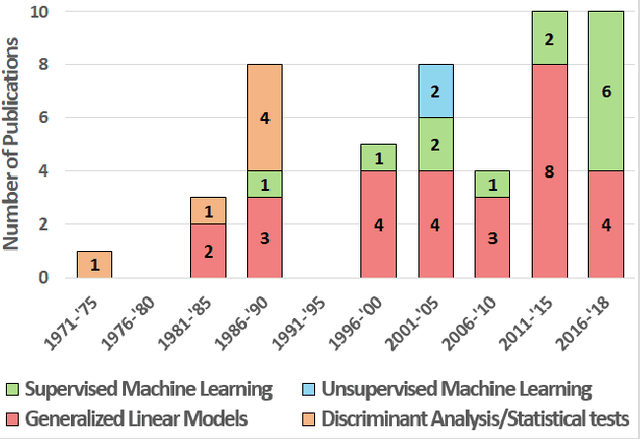
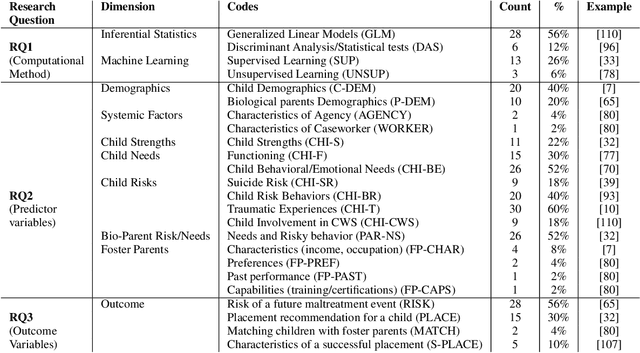
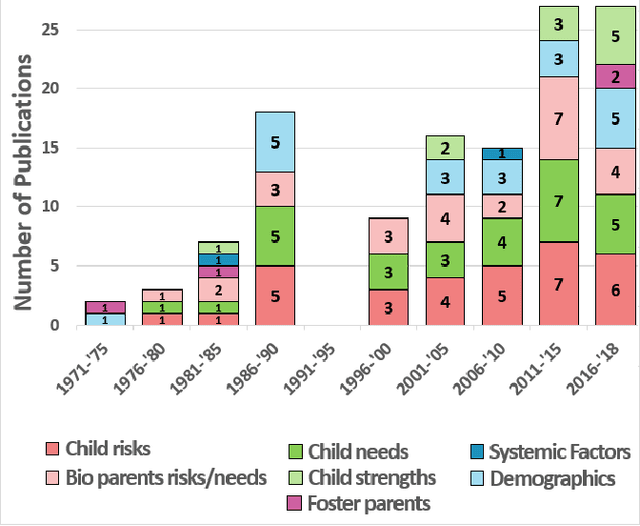
Abstract:The U.S. Child Welfare System (CWS) is charged with improving outcomes for foster youth; yet, they are overburdened and underfunded. To overcome this limitation, several states have turned towards algorithmic decision-making systems to reduce costs and determine better processes for improving CWS outcomes. Using a human-centered algorithmic design approach, we synthesize 50 peer-reviewed publications on computational systems used in CWS to assess how they were being developed, common characteristics of predictors used, as well as the target outcomes. We found that most of the literature has focused on risk assessment models but does not consider theoretical approaches (e.g., child-foster parent matching) nor the perspectives of caseworkers (e.g., case notes). Therefore, future algorithms should strive to be context-aware and theoretically robust by incorporating salient factors identified by past research. We provide the HCI community with research avenues for developing human-centered algorithms that redirect attention towards more equitable outcomes for CWS.
 Add to Chrome
Add to Chrome Add to Firefox
Add to Firefox Add to Edge
Add to Edge